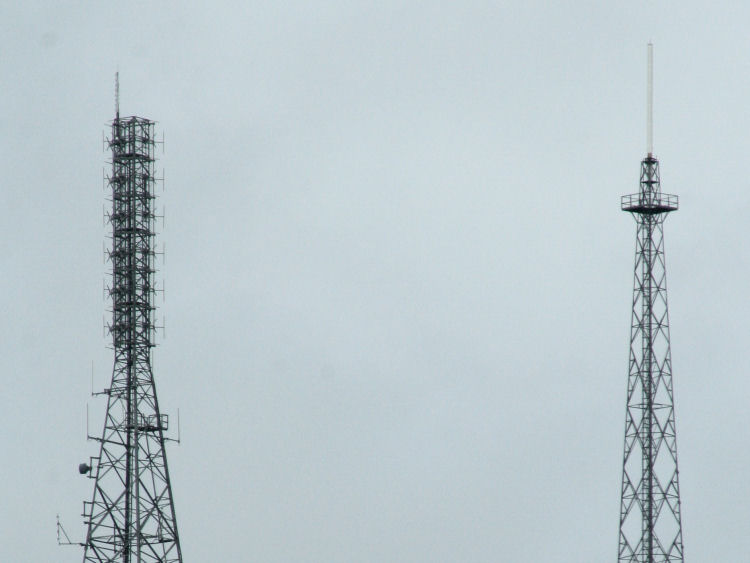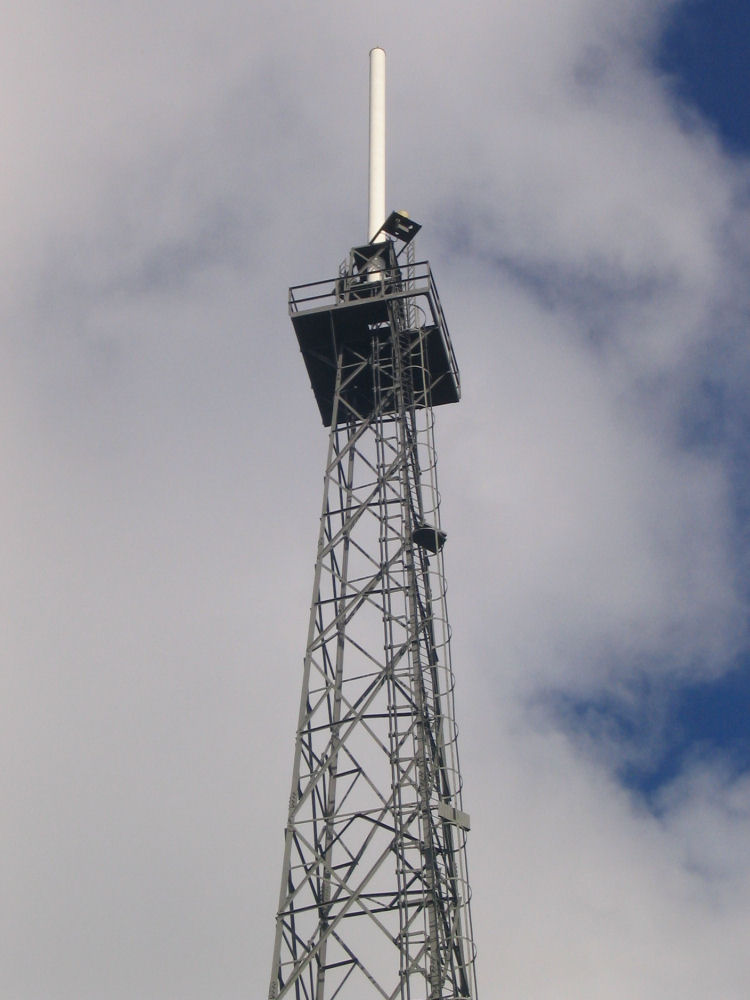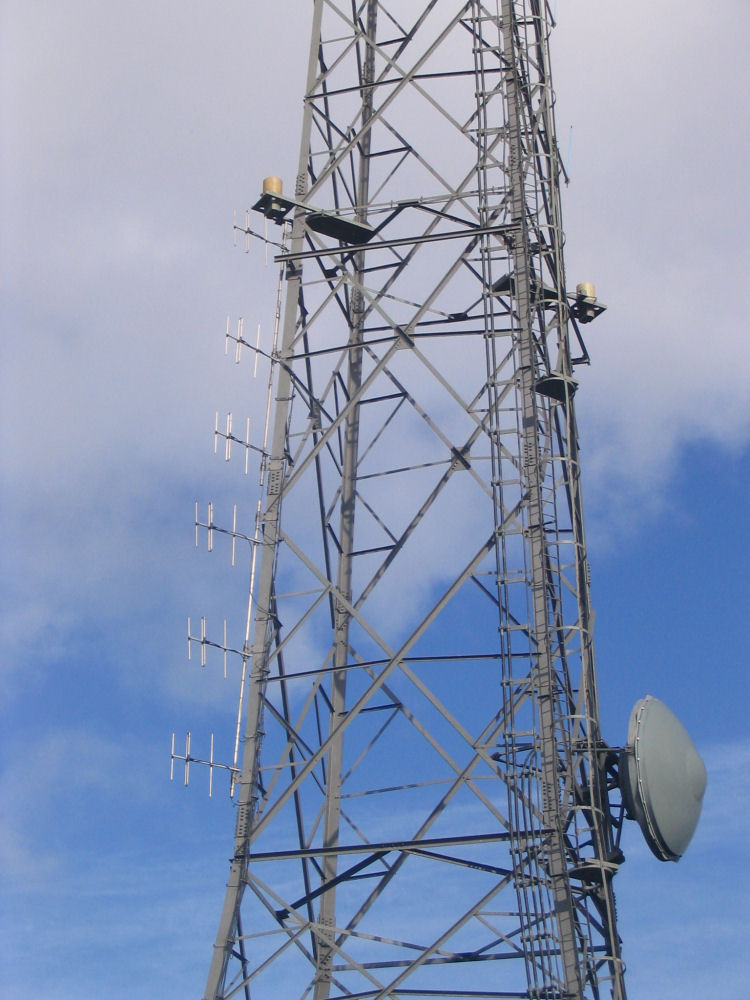 |
UK Broadcast Transmission |
|
|||||||||||
THE TRANSMISSION GALLERY
BRESSAY A
| Photos by Nigel Coote and Dave Stephen | Page last updated: 2024-02-20 |
| Technical info from Ian Anderson, SIBC. Additional text by Mike Smith Additional material from Mark Carver As at Keelylang Hill there are two towers at Bressay. The current towers are Bressay Mk 2 and Mk 3. There is a link at the foot of this page to the BBC RD report on the original Mk 1 tower, which entered service on 15-Apr-1964 with both 405-line, VHF channel 3, BBC TV and FM radio. The 405-line TV service closed on 4-Apr-1983. Bressay Mk 2 is a 70m tower built for UHF TV, which entered service with ITV on 24-Dec-1976. BBC1 & 2 from June 1977 and Channel 4 from November 1984. Interim DTT entered service in February 2000. DSO was on 5th and 19th May 2010. Bressay Mk 3 is a 71.5m tower built for the re-engineering of BBC FM radio to mixed polarisation and went into service in March 1986. Radio's 1 & 4 were added on 10th December 1993. ILR Shetland (SIBC) was added in October 1991. A UHF Tx aerial was added to the top of this tower for interim DTT multiplexes C & D, being out of group, on UHF Ch's 66 & 68 and therefore unable to use the Mk 2 tower UHF aerial. |








| There are also no less than six stacked VHF receive yagis for the ILR service. The programmes for SIBC were originally fed to the Bressay site from the studio in Lerwick via a low power radio link on 102.2 MHz (20W vertical), which also acts as a small filler for the town. Since 1994, however, the feed from the studio to the transmitter has been via UHF link. The 102.2 MHz transmitter is now essentially a standby service that listeners can retune to should Bressay fail, which has happened. |

| The second tower is used for VHF/FM radio broadcasting and this transmits the high power BBC national and local opt-out services together with the lower power Independent Local Radio station SIBC (Shetland Isles Broadcasting Company). |


| The transmitting aerials used by the BBC radio services are the six tiers of large "Coniex" crossed dipole aerial panels on three of the four faces, at the top of the 'radio mast'. Just above the Coniex panels there are UHF aerials which carried two of the pre-DSO DTT multiplexes (C & D). The others were carried via the main UHF aerials on the other tower. |

| Lower down the tower we see the two Rx logs for the BBC's RBS link from Keelylang Hill. The main programme feed is via SHF link from Fair Isle. Below the Orange mobile phone panels are SIBC's two vertical Marconi R1000 dipoles with rear reflectors. OFCOM quote the SIBC service at 4kW but SIBC's Ian Anderson thinks this is undercalculated: "If the BBC is "high power" we cannot be "low power" since were are on parity with the weakest of the BBC services (the variance in the Q of the aerial system means that the services ERPs are not all the same) in some lobes, and no more than 4-5dB down in general. It has been like that for 10 years, with 1dB increased reflection from the Orange metal work (just above) added a few years ago. It just shows that a well placed dipole pair with reflectors can be relatively efficient, even against eighteen Coniex crossed dipole panels". The ERP of SIBC is no worse than 4-5dB on the BBC in some directions and parity in others. The BBC's horizontal pattern is like the petals of a flower and the parity is in the directions where we have a gain and they have a slight null. In one direction (roughly towards Lerwick) we have massive reflection of the tower (we are low down on the tower so there is a lot of metal behind us, and to the side) and Orange's metal work above added 1dB when it was installed by reflecting our signal downwards. The Radio Authority did a computer model and gave our maximum lobe as 9dB because of the metal work, so that would be 16kW less feeder loss (c 1dB). We are probably about 12.5kW max in that direction, which is only 3dB down from the maximum of 25kW vertical that we are allowed. We usually quote about 12.5kW vertical towards Lerwick, Brae etc. The horizontal radiation is interesting. With no horizontal element, we are actually less than 10dB down on horizontal, all because of reflections of the tower, the hillsides and twisting in free space, giving about 1kW all for free! We are also less prone to some kinds of multipath than the BBC. When the hills are wet from rain, the soaked peat also helps to conduct our signal over to the back of hills. Normally there is increasing attenuation when the declination behind a hill is greater than 7 degrees, but wet hills help. Attenuation due to mist and drizzle the short distance between Lerwick and Bressay, combined with scatter reflection of the small droplets, can be as much as 1dB. And when very large ship enters the harbour we can see a change in signal strength from -3dB to 2dB. Recently a crane worked 100 yards away and the same changes were witnessed. The moral of the story is that you can used scorched earth power like the BBC and lose it all because of local circumstances. Ian Anderson SIBC |


| Above: the view from the hill with the radio tower on the left and the television tower on the right |


| SHF links gong north and south??? For analogue UHF TV, Bressay took its broadcast feeds from Keelylang Hill on Orkney. These were received off air at a link station on Fair Isle and sent on from there to Bressay at SHF. The article 'Bringing Colour TV to the Shetland Isles' gives details of how the Fair Isle link was planned and established. The article was first published in July 1976 in IBA Tech Review 7: Service Planning and Propagation. James Muir comments: "I recall being extremely impressed with the quality of colour broadcast pictures from the Bressay UHF transmitter that I viewed during my holiday, particularly those of the BBC. Wimbledon coverage on the TV set in my hotel room was absolutely flawless, and quite a technical achievement (even in 1995) when you think of the transmission chain from London 1000 miles to the south, and in particular the RBL path from Rosemarkie some 200 miles to the south." |
Fair Isle (link site) | Keelylang Hill A
SIBC
BBC RD: Transmitting aerials for the Shetland station 1964
BBC Archive YouTube video about the start of TV in Shetland (1964)
| |
Back to TX Gallery index | TX main index
|